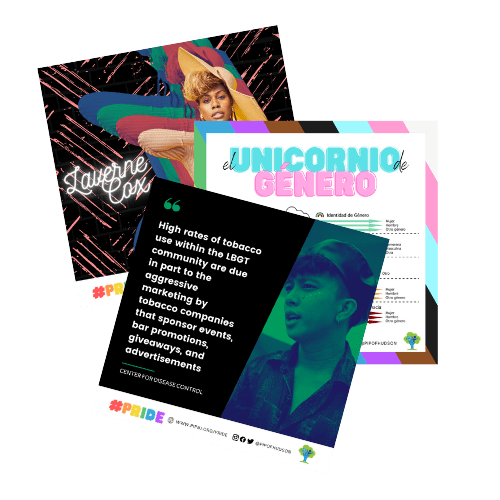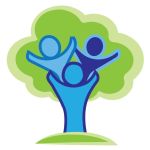PRIDE Toolkit
LGBTQ+ Education & Resources
Download Your Toolkit & Workbook Here!
Sign up below and have the PRIDE Month Toolkit: LGBTQ+ Education & Resources and the LGBTQ+ Youth Activities Workbook sent to you by email. Scroll the the bottom of the page to download our free social media assets and messaging.
This toolkit has been developed to help any interested party learn more about the LGBTQ+ community and its history in the United States. Our goal is to educate our communities and provide resources for prevention and treatment professionals, schools, youth-serving organizations, parents, and anyone looking to become a better ally.
What is PRIDE?
Lesbian, Gay, Bisexual, Transgender, and Queer (LGBTQ) Pride Month is currently celebrated each year in the month of June to honor the 1969 Stonewall Uprising in Manhattan. The Stonewall Uprising was a tipping point for the Gay Liberation Movement in the United States. In the United States the last Sunday in June was initially celebrated as ‘Gay Pride Day,’ but the actual day was flexible.
In major cities across the nation, the ‘day’ soon grew to encompass a month-long series of events. Today, celebrations include pride parades, picnics, parties, workshops, symposia, and concerts, and LGBTQ Pride Month events attract millions of participants around the world. Memorials are held during this month for those members of the community who have been lost to hate crimes or HIV/AIDS. The purpose of the commemorative month is to recognize the impact that lesbian, gay, bisexual, and transgender individuals have had on history locally, nationally, and internationally.
In 1994, a coalition of education-based organizations in the United States designated October as LGBT History Month. In 1995, a resolution passed by the General Assembly of the National Education Association included LGBT History Month within a list of commemorative months. National Coming Out Day (October 11), as well as the first ‘March on Washington’ in 1979, are commemorated in the LGBTQ community during LGBT History Month.
Source: The Library of Congress
The Queer Umbrella
 LGBTQ+ is an acronym meant to encompass a whole bunch of diverse sexualities and genders. People often refer to the Q (standing for “queer”) as an umbrella term, under which live a whole bunch of identities. This is helpful because lesbian, gay, and bisexual are the only marginalized sexualities, and transgender isn’t the only gender identity. In fact, there are many more in both!
LGBTQ+ is an acronym meant to encompass a whole bunch of diverse sexualities and genders. People often refer to the Q (standing for “queer”) as an umbrella term, under which live a whole bunch of identities. This is helpful because lesbian, gay, and bisexual are the only marginalized sexualities, and transgender isn’t the only gender identity. In fact, there are many more in both!
LGB all represent sexual identities. And the T represents a gender identity. And the Q — sometimes referring to “Questioning,” but generally meaning “Queer” — is often used as an umbrella term, in an affirming and positive way, to lump all marginalized sexualities and genders together.
We’d like to draw your attention to the umbrella handle itself because while these identities are all often grouped together, we’re talking about distinctly different aspects of our humanity and experience: sexuality and gender.
When we say sexual identities, sexualities, or sexual orientations, we are talking about the ways we categorize and define whom we are attracted to. When we “gender identities” we are talking about the ways we categorize and define our genders.
So, to recap: on one side we have queer sexualities (Lesbian, Gay, and Bisexual, to name a few), and on the other, we have queer genders (Transgender, to name one), and we often group all of these under the umbrella term of “queer.”
1969 — The Stonewall Riot
The Stonewall Inn Riots sparked the beginning of the gay rights movement in America. Learn how members of the LGBTQ community came together to protest exploitation and police harassment.
1969 — The First Pride Parade
The first Pride march in New York City was held on June 28, on the one-year anniversary of the Stonewall Uprising.
1999 — Gay and Lesbian Pride Month
President Bill Clinton issued the first-ever proclamation declaring June to be Gay and Lesbian Pride Month.

2011 — LGBT Pride Month
President Barack Obama proclaimed June as Lesbian, Gay, Bisexual, and Transgender Pride Month.
Intersectionality
Intersectionality
We all have multiple identities that intersect to make us who we are. This includes our race, gender, ability, sexuality, etc. Intersectionality allows us to see how those identities and the way they are oppressed overlap and reinforce each other.
Coined by Kimberlé Crenshaw in the ’80s, intersectionality was used to help understand how black women endure gender and racial discrimination, and how that combination makes their experiences different from white women and black men. Since then scholars and activists and expanded the use of the word to talk about identities beyond race and gender.
“It’s basically a lens, a prism, for seeing the way in which various forms of inequality often operate together and exacerbate each other. We tend to talk about race inequality as separate from inequality based on gender, class, sexuality or immigrant status. What’s often missing is how some people are subject to all of these, and the experience is not just the sum of its parts.” – Kimberlé W. Crenshaw
Kimberlé W. Crenshaw is a pioneering scholar and writer on civil rights, critical race theory, Black feminist legal theory, and race, racism and the law. In addition to her position at Columbia Law School, she is a Distinguished Professor of Law at the University of California, Los Angeles.
Crenshaw’s work has been foundational in critical race theory and in “intersectionality,” a term she coined to describe the double bind of simultaneous racial and gender prejudice. Her studies, writing, and activism have identified key issues in the perpetuation of inequality. Through the Columbia Law School African American Policy Forum, which she co-founded, Crenshaw co-authored “Say Her Name: Resisting Police Brutality Against Black Women”, which documented and drew attention to the killing of Black women and girls by police.
Tobacco Use
Tobacco is the leading cause of preventable death in the United States. Lesbian, gay, bisexual, transgender, and queer (LGBTQ+) persons have demonstrated a persistent tobacco use disparity in this country. Over the years, smoking rates have ranged from 60% higher than average to the current 40% higher than average. While smoking-related data in this population is limited, especially among transgender persons, the existing data shows how disproportionately affected this population is by tobacco use.
According to the Truth Initiative, 20.6% of lesbian, gay, and bisexual adults and 35.5% of transgender adults smoke cigarettes compared to 14.9% of heterosexual adults. The campaign also states that more than twice as many lesbian, gay, and bisexual students in grades 9 to 12 have smoked a cigarette before the age of 13 compared to their heterosexual peers. Studies found that lesbian and bisexual women having two and three times the odds (respectively) of smoking and having higher relative odds of experimental tobacco use than heterosexual women.
Unfortunately, the rapid growth of e-cigarettes has begun to exacerbate this disparity – new surveillance data show overall tobacco use rates increasing among this population, currently, they are 50% higher than average. Research shows these disparities among the LGBTQ+ community exist largely due to targeted marketing strategies by Big Tobacco industries, such as sponsoring Pride events and advertising in LGBTQ+ media.
2015— Supreme Court Ruling on Marriage
The Supreme Court declared same-sex marriage a Constitutional right nationwide.
2016 — Stonewall National Monument
On Friday, June 24, President Obama designated the Stonewall National Monument – the first national monument dedicated to telling the story of the lesbian, gay, bisexual and transgender community’s struggle for equal rights.
Social Media Images
Use our social media images below with the messaging provided in the toolkit to create an informative and useful social media campaign. To download the image click on the thumbnail below, then right click the image and select Save As.
Make sure to use the #PartnersInPride and other local/related hashtags and tag @PIPofHudson on social media.
Imágenes de redes sociales
Utilice nuestras imágenes de redes sociales a continuación con los mensajes proporcionados en el kit de herramientas para crear una campaña de redes sociales informativa y útil. Para descargar la imagen, haga clic en la miniatura a continuación, luego haga clic con el botón derecho en la imagen y seleccione Guardar como.
Asegúrese de usar #PartnersInPride y otros hashtags locales / relacionados y a @PIPofHudson en las redes sociales.



